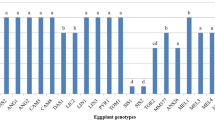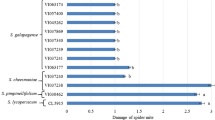Abstract
With more than 200 host plant species, the two-spotted spider mite, Tetranychus urticae Koch (Acari: Tetranychidae), is one of the most common and destructive pests of agricultural crops including vegetables, fruits, field crops and ornamentals in both open-field and greenhouse cultivations in Turkey. Control of this pest generally depends on the use of synthetic pesticides. The use of resistant plant varieties in conjunction with other control tactics generates more effective and sustainable results in management of many pests. In the present study, a total of 16 eggplant genotypes, including eight wild sources and eight standard commercial cultivars, were evaluated for the first time using free-choice and bridge test methods for their resistance against this mite under controlled conditions. Resistance was evaluated by counting mites settled on plants of each genotype. Resistance data were calculated by taking mean number (no.) of mites that prefer the plants of susceptible or resistant genotypes at each time interval (1, 3, 5, 7 or 9 days after releasing mites in free-choice tests; 30 min, 1, 2 or 3 h in bridge tests). The results from free-choice tests showed that wild genotype, Solanum sisymbriifolium (from INRA, France) was the most resistant genotype to T. urticae with no settlement of mites per plant both at 7 and 9 days after releasing mites, and followed by two commercial S. melongena genotypes (Topan 374 and Kemer) that had 2.25 and 2.50, 4.25 and 3.50 mites per plant, respectively, on the 7th and 9th days of mite introduction. S. sisymbriifolium was also found to be the most resistant genotype in bridge tests with a mean no. of 13.0 mites per plant. These results can be used for breeding and management purposes for control of two-spotted spider mite.



Similar content being viewed by others
Abbreviations
- IPM:
-
Integrated Pest Management
- BATEM:
-
Bati-Akdeniz Agricultural Research Institute
- INRA:
-
The French National Institute for Agricultural Research
- RH:
-
Relative humidity
- L:D:
-
Light: Dark
- DMRT:
-
Duncan’s Multiple Range Test
- NPK:
-
Nitrogen, Phosphorus and Potassium
References
Agrawal, A. A. (2000). Host-range evolution: Adaptation and trade-offs in fitness of mites on alternative hosts. Ecology, 81, 500–508.
Alba, J. M., Montserrat, M., & Muñoz, F. (2009). Resistance to the two-spotted spider mite (Tetranychus urticae) by acylsucroses of wild tomato (Solanum pimpinellifolium) trichomes studied in a recombinant inbred line populations. Experimental & Applied Acarology, 47, 35–47.
Alizade, M., Hosseini, M., Awal, M. M., Goldani, M., & Hosseini, A. (2016). Effects of nitrogen fertilization on population growth of two-spotted spider mite. Systematic and Applied Acarology, 21(7), 947–956.
Bulut, E., & Gocmen, H. (2000). Pests and their natural enemies on greenhouse vegetables in Antalya. Integrated Control in Protected Crops, Mediterranean Climate, IOBC/wprs Bull., 23, 33–37.
Chen, Y., Opit, G. P., Jonas, V. M., Williams, K. A., Nechols, J. R., & Margolies, D. C. (2007). Two-spotted spider mite population level, distribution, and damage on ivy geranium in response to different nitrogen and phosphorus fertilization regimes. Journal of Economic Entomology, 100(6), 1821–1830.
El-Kady, G. A., El Sharabasy, H. M., Mahmoud, M. F., & Bahgat, I. M. (2007). Toxicity of two potential bio-insecticides against moveable stages of Tetranychus urticae Koch. Journal of Applied Sciences Research., 3, 1315–1319.
El-Sadan, M. F. I. (2018). Influence of host plants and some leaf contents on biological aspects of Tetranychus urticae Koch (Arachnida: Acari: Tetranychidae). The Journal of Basic and Applied Zoology (JoBAZ), 79, 20.
Erler, F., Ates, A. O., & Bahar, Y. (2013). Evaluation of two entomopathogenic fungi, Beauveria bassiana and Metarhizium anisopliae, for the control of carmine spider mite, Tetranychus cinnabarinus (Boisduval) under greenhouse conditions. Egypt J Biol Pest Control, 23(2), 233–240.
FAO STAT (2020) Agricultural Data. http://faostat.fao.org (accessed 27 July 2020).
Figueiredo, A. S. T., Resende, J. T. V., Morales, R. G. F., Gonçalves, A. P. S., & Da Silva, P. R. (2013). The role of glandular and non-glandular trichomes in the negative interactions between strawberry cultivars and spider mite. Arthropod-Plant Interactions, 7, 53–58.
GKGM (2016) Eggplant Disease and Pest Management. https://www.tarimorman.gov.tr/GKGM (accessed 15 February 2020).
Glass, J. J., Schimmel, B. C., Alba, J. M., Escobar-Bravo, R., Schuurink, R. C., & Kant, M. R. (2012). Plant glandular trichomes as targets for breeding or engineering of resistance to herbivores. International Journal of Molecular Sciences, 13, 17077–17103.
Gong, Y. J., Chen, J. C., Zhu, L., Cao, L. J., Jin, G. H., Hoffmann, A. A., Zhong, C. F., Wang, P., Lin, G., & Wei, S. J. (2018). Preference and performance of the two-spotted spider mite Tetranychus urticae (Acari: Tetranychidae) on strawberry cultivars. Experimental and Applied Acarology, 76, 185–196.
Hasanuzzaman, A. T. M., Islam, M. N., Zhang, Y., Zhang, C. Y., & Liu, T. X. (2016). Leaf morphological characters can be a factor for intra-varietal preference of whitefly Bemisia tabaci (Hemiptera: Aleyrodidae) among eggplant varieties. PLoS One, 11(4), e0153880.
Jackson, M. L. (2005). Soil chemical analysis: Advanced course. Madison, WI: UW-Madison Libraries Parallel Press.
Lester RN, Hasan SMZ (1991) Origin and domestication of the brinjal eggplant, Solanum melongena, from S. incanum, in Africa and Asia. In: J.G., Hawkes, R.N., Lester, M., Nee & N., Estrada-R (Eds). Solanaceae III, pp. 369–387. Royal Botanic Gardens, Kew, Richmond (U.K.).
Maluf, W. R., Inoue, I. F., Ferreira, R. P. D., Gomes, L. A. A., Castro, E. M., et al. (2007). Higher glandular trichome density in tomato leaflets and repellence to spider mites. Pesqui. Agropecu. Bras., 42, 1227–1235.
Mitchell, C., Brennan, R. M., Graham, J., & Karley, A. J. (2016). Plant defense against herbivorous pests: Exploiting resistance and tolerance traits for sustainable crop protection. Frontiers in Plant Science, 7, 1132.
Olsen SR, Cole CV, Watanabe FS, Dean LA (1954) Estimation of Available Phosphorus in Soils by Extraction with Sodium Bicarbonate. Circular, Vol. 939 (p. 19). Washington, DC: US Department of Agriculture.
Onyambus, G. K., Maranga, R. O., Gitonga, L. M., & Knapp, M. (2011). Host plant resistance among tomato accessions to the spider mite Tetranychus evansi in Kenya. Experimental & Applied Acarology, 54, 385–393.
Pietrosiuk, A., Furmanowa, M., Kropczyńska, D., Kawka, B., & Wiedenfeld, H. (2003). Life history parameters of the two-spotted spider mite (Tetranychus urticae Koch) feeding on bean leaves treated with pyrrolizidine alkaloids. Journal of Applied Toxicology, 23(3), 187–190.
Rakha, M., Bouba, N., Ramasamy, S., Regnard, J., & Hanson, P. (2017). Evaluation of wild tomato accessions (Solanum spp.) for resistance to two-spotted spider mite (Tetranychus urticae Koch) based on trichome type and acylsugar content. Genet. Resources Crop Evol., 64, 1011–1022.
Russo, V. M. (1996). Cultural methods and mineral content of eggplant (Solanum melongena) fruit. Journal of the Science Food and Agriculture, 71(1), 119–123.
Sadilova, E., Stintzing, F. C., & Carle, R. (2006). Anthocyanins, colour and antioxidant properties of eggplant (Solanum melongena L.) and violet pepper (Capsicum annuum L.) peel extracts. Zeitschrift für Naturforschung, 61(7–8), 527–535.
Saeidi, Z., Mallik, B., & Kulkarni, R. S. (2007). Inheritance of glandular trichomes and twospotted spider mite resistance in cross Lycopersicon esculentum ‘Nandi’ and L. pennellii ‘LA2963. Euphytica, 154, 231–238.
Sharma, H. C., & Ortiz, R. (2002). Host plant resistance to insects: An eco-friendly approach for pest management and environment conservation. Journal of Environmental Biology, 23(2), 111–135.
Sharma, H. C., Vidyasagar, P., & Nwanze, K. F. (1993). Effect of host-plant resistance on economic injury levels for the sorghum midge. Contarinia sorghicola. Int. Pest Manag., 39, 435–444.
Sihachakr, D., Daunay, M. C., Serraf, I., Chaput, M. H., Mussio, I., Haricourt, R., Rotino, L., & Ducreux, G. (1994). Somatic hybridization of eggplant (Solanum melongena L.) with its close and wild relatives. In Y. P. S. Bajaj (Ed.), Biotechnology in agriculture and forestry: Somatic hybridization in crop improvement (pp. 255–278). Berlin: Springer.
Skorupska, A. (2004). Resistance of apple cultivars to two-spotted spider mite, Tetranychus urticae Koch (Acarina, Tetranychidae) part II. Influence of leaf pubescence of selected apple cultivars on fecundity of two-spotted spider mite. Journal of Plant Protection Research, 44(1), 69–74.
Smith, C. M. (1989). Plant resistance to insects (p. 286). New York: John Wiley and Sons.
SPSS (2008) Base 10.0 Application Guide. SPSS, Chicago, IL, USA.
Taher, D., Mohamed, A., Rakha, M. A., Ramasamy, S., Solberg, S. Ø., & Schafleitner, R. (2019). Sources of resistance for two-spotted spider mite (Tetranychus urticae) in scarlet (Solanum aethiopicum L.) and gboma (S. macrocarpon L.) eggplant germplasms. HortScience, 54(2), 240–245.
Tian, D., Tooker, J., Peiffer, M., Chung, S. H., & Felton, G. W. (2012). Role of trichomes in defense against herbivores: Comparison of herbivore response to woolly and hairless trichome mutants in tomato (Solanum lycopersicum). Planta, 236, 1053–1066.
Topuz, E., & Erler, F. (2007). Bioefficacy of some essential oils against the carmine spider mite. Tetranychus cinnabarinus. Fresenius Environ Bull, 16, 1498–1502.
Topuz, E., Erler, F., & Gumrukcu, E. (2016). Survey of indigenous entomopathogenic fungi and evaluation of their pathogenicity against the carmine spider mite, Tetranychus cinnabarinus (Boisd.), and the whitefly, Bemisia tabaci (Genn.) biotype B. Pest Management Science, 72(12), 2273–2279.
Topuz, E., Madanlar, N., & Erler, F. (2012). Evaluation of fumigant toxicity of Mentha pulegium essential oil against Tetranychus cinnabarinus under greenhouse conditions. Fresenius Environmental Bulletin, 21, 2739–2745.
van den Boom, C. E. M., van Beek, T. A., & Dicke, M. (2003). Differences among plant species in acceptance by the spider mite Tetranychus urticae Koch. Journal of Applied Entomology, 127(3), 177–183.
Wermelinger, B., Oertli, J. J., & Baumgärtner, J. (1991). Environmental factors affecting the life-tables of Tetranychus urticae (Acari: Tetranychidae) III. Host-plant nutrition. Experimental & Applied Acarology, 12, 259–274.
White, J. W., & Montes, R. C. (2005). Variation in parameters related to leaf thickness in common bean (Phaseolus vulgaris L.). Field Crops Research, 91, 7–21.
Zhang ZQ (2003). Mites of greenhouses: identification, biology and control. p. 244. Cambridge: CABI Publishing.
Availability of data and materials
All data generated or analyzed in this study are available in this published manuscript.
Funding
This project was financially supported by TAGEM (General Directorate of Agricultural Research and Policies, Ankara, Turkey) (Project No. TAGEM/BBAD/10/A09/P01/12).
Author information
Authors and Affiliations
Corresponding author
Ethics declarations
Ethics approval and consent to participate
Not applicable.
Consent for publication
Not applicable.
Additional information
Publisher’s note
Springer Nature remains neutral with regard to jurisdictional claims in published maps and institutional affiliations.
Rights and permissions
About this article
Cite this article
Kirisik, M., Erler, F., Boyaci, F. et al. Evaluation of resistance in 16 eggplant genotypes to the two-spotted spider mite, Tetranychus urticae Koch (Acari: Tetranychidae). Phytoparasitica 49, 275–285 (2021). https://doi.org/10.1007/s12600-020-00856-x
Received:
Accepted:
Published:
Issue Date:
DOI: https://doi.org/10.1007/s12600-020-00856-x




